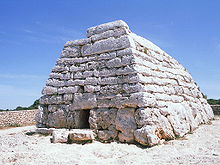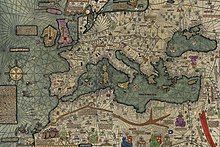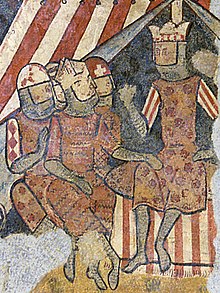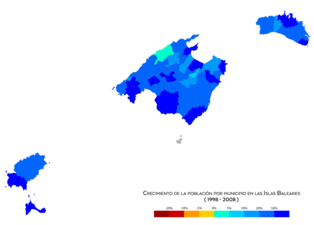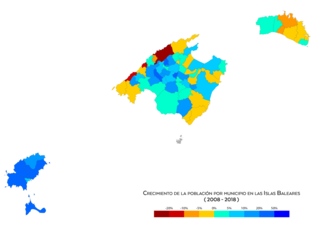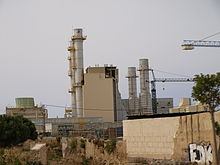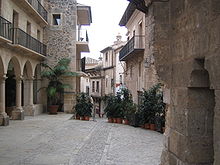Balearic Islands
The Balearic Islands (officially in Catalan, Illes Balears) are a Spanish single-province autonomous community, made up of the islands of the Balearic archipelago. It is located in the Mediterranean Sea, off the eastern coast of the Iberian Peninsula. Its capital is Palma.
The archipelago is made up of two groups of islands and numerous islets: the Gimnesias islands (Mallorca, Menorca, Cabrera and some nearby islets such as Dragonera, Conejera, the Aire island or the Colom island - privately owned -) and the Pitiusas islands (Ibiza and Formentera, together with the islets that surround them, such as Espalmador - privately owned - and Espardell).
Etymology
Despite the fact that for a long time it has been believed that «Baleares» came from the Greek word ballein, which means «to launch», lately there has been a change of opinion and it seems that the origin is ruled out Hellenic. The truth is that the Greeks used the word gymnastics to refer to the islands of Menorca and Mallorca. Instead, Carthaginians and Romans preferred the name "Baleares" for Menorca and Mallorca. They all called Ibiza and Formentera Pitiusas. The origin of the name "Baleares" is not Greek but Punic, and comes from the plural ba' lé yaroh. The noun ba' lé means "those who exercise the trade of" and acts as the subject of the verb yaroh which means "throw stones". The final meaning would be something like "the throwing masters". And these throwing masters were the slingers of the islands. Thus, Baleares means "slingers". Classical authors such as Pliny the Elder or Diodoro Siculo have spoken a lot about them.
Geography
The geography of the archipelago of the Balearic Islands includes Mallorca, Cabrera, Menorca, Ibiza and Formentera. In total, the territory has 4,992 km² and goes from sea level to 1,445 m above sea level in the Puig Mayor of the Sierra de Tramontana in Mallorca. The geographic coordinates are between 40º5'48' and 38º40'30' latitude N and between 1º12'47' and 4º19' longitude E. Ibiza is separated from the coast of the Valencian Community by only 75 km of sea, this same distance separates Mallorca from Ibiza. The minimum distance that separates Mallorca from Menorca is 35 km. The closest island to the European continent (not counting the Iberian Peninsula) is Menorca, since its north coast borders France through the Gulf of Lion, while Ibiza and Formentera are the closest islands to the African continent. There are notable differences in the landscape of the islands, Menorca and Mallorca being more fertile both in flora (with abundant presence of wild olive trees and holm oaks) and in fauna (more abundance of mammals), apart from being rainier and colder, unlike Ibiza and Formentera, which lack fertile vegetation, abounding in simpler flora that does not require as much water, such as pine trees, Mediterranean cacti and junipers, and a fauna dominated mainly by birds.
| Island | Position | Map | Flag | Surface (km2) | Inhabitants |
| Menorca |  | 696.73 | 91 920 | ||
| Mallorca |  |  | 363.99 | 880 113 | |
| Cabrera |  |  | 15,61 | 20 | |
| Ibiza |  |  | 571.01 | 144 659 | |
| Formentera |  | 83.27 | 12 216 |
Paleogeography
Gimnesias and Pitiusas have had a different geographical history. During the Quaternary glaciations, due to the accumulation of water in the form of ice in the polar caps and in the great mountains, seas and oceans dropped in level. This caused Menorca and Mallorca to join on the one hand and Ibiza and Formentera on the other [citation required]. All the faunas and floras were mixed, but between Gran Gimnesia and Gran Pitiusa this was not the case, since a marine channel of more than 70 km remained, impassable by terrestrial fauna. The smaller size of the Great Gymnasium (2000 km²) and a more arid climate caused the extinction of the terrestrial fauna and the lack of notable arboreal plants.
Flora and fauna
In the past, Gimnesias and Pitiusas had different ecosystems. Las Gimnesias had holm oak forests in the interior and on the coastal plains large forests of Balearic boxwood (Buxus balearica), a plant that can still be found residually in Mallorca. The Pitiusas were practically bare of arboreal vegetation and nitrophilous herbs predominated as a result of the effect of the droppings of the large number of bird colonies they had.
There are currently numerous endemic plants in the Balearic Islands, among others Apium bermejoi, Euphorbia fontqueriana, Euphorbia margalidiana, Euphorbia pithyusa, Galium balearicum, Galium crespianum, Galium friedrichii or Helleborus lividus.
In the past, the fauna of the Gimnesias and the Pitiusas were very different. It seems that, with the exception of flying species (birds, bats and flying insects) they shared almost no terrestrial species: different plant communities, different herbivores, different carnivores such as Hypnomys morpheus, Myotragus or Nesiotites hidalgo.
It has some endemic species such as the Balearic toad (Alytes muletensis), or the Balearic lizards (Podarcis lilfordi) and the Pitiusas (Podarcis pityusensis).
History
Prehistory and ancient history
The Prehistory and ancient history of the Balearic Islands needs to differentiate between the islands of Majorca and Menorca and those of Ibiza and Formentera.
On the islands of Majorca and Menorca, the first clear evidence of a stable population dates back to the 3rd millennium BC. C. Currently its prehistory is divided into five successive phases:
- First settlers
- Calcolytic phase
- Naviforme phase (c. 1500 - 850 cal a. C.)
- Talayotic phase (c. 900 - 550 lime a. C.)
- Postalayotic phasec. 550 lime a. C. - 123 a. C.)
In the case of Ibiza and Formentera, the presence of a stable population is similar to that of the larger islands but around 654 BC. C. (mid-VII century) the confirmed presence of Phoenician settlements appears, probably coming from Gadir rather than from the East in the settlements of Sa Caleta and Vila (Iboshim), thus making the city the first to be founded in the archipelago and a one of the first in Spain. From Iboshim a flourishing trade linked the islands with all points of the Mediterranean, with imported or own products such as salt from Ibiza or Mallorca, exploited by the Iboshitans from the islets of Na Guardis or Na Galera, in Mallorca.
The Romans conquered the islands of Mallorca and Menorca and allied with Iboshim around 123 BC. C., unifying for the first time the entire archipelago under the same administration and the same culture (because there was a dichotomy of the ethnic background —which currently persists in an insurmountable difference in culture— between the Pitiusas, populated by Phoenicians, and the Gimnesias, with people belonging to the Talayotic culture), although the Roman colonization was not very intense. Initially incorporated into Hispania Citerior, and later into Tarraconensis, the islands formed part of the Carthaginian province during the Low Empire, and at the end of the 4th century they became an independent province (Balearica).
High Middle Ages
In the year 406 the frost of the Rhine facilitated the entry of Germanic peoples (Suevos, Vandals and Alans), who in the year 409 crossed the Pyrenees to settle temporarily on the Peninsula. In the year 429 the Balearic Islands were looted together with Cartagena, Seville and the rest of Hispania, according to the historian Hidacio. After that they crossed the strait founding the Vandal Kingdom, incorporating the islands in the year 455. Later, in the year 534, they were conquered by the troops of Justinian I and integrated into the Byzantine Empire until the beginning of the 8th century. The economic and demographic crisis of the archipelago, throughout the 7th to the 9th centuries, exposed them increasingly to external attacks. After a stage of incursions, the Emirate of Córdoba occupied them in the year 903. Subsequently, they depended on the Taifa of Denia (1013 - 1067), the Almoravid Empire (1120 - 1203) and the Almohads (1203 until the conquest Christian).
Christian reconquest
The Crown of Aragon experienced a strong expansion towards the Mediterranean during the 12th and 13th centuries, which took it to the Balearic Islands. The origin of the current extension of Catalan is found in the Crown of Aragon, where Catalan was the dominant and most widely spoken language, spoken by 80% of the population. Jaime I of Aragon led a fleet that landed in Mallorca at the end of the summer of 1229. After long battles that lasted for months, the king entered the city victorious on December 31 of that same year. The assault was followed by an indiscriminate massacre that caused a veritable genocide of the Mallorcan population; so much so that the thousands of corpses that could not be buried caused an epidemic among the conquerors that caused numerous casualties. As a consequence, the nobles wanted to keep all the loot instead of raffling it off among the troops. This caused the revolt of pawns and knights. Finally, the distribution of the booty took place, which lasted until April 30, 1230.
Thanks to all this, the surviving Muslims had time to organize various pockets of resistance in the mountains, which prolonged the fights against the Muslims of Mallorca for a couple of years, who eventually ended up becoming slaves or semi-slaves. Thus, the Balearic Islands were repopulated mainly by peasants from Roussillon, Gerona and Barcelona.
All this destruction also weakened the army of Jaime I to the point that, when Menorca asked for the vassalship of the Crown, it was granted. Thus, Menorca became an autonomous Taifa, where the Arab religion and culture were maintained for half a century. But in January 1287, the fleet of Alfonso III, the Franco, arrived at the port of Mahón. The capitulation of the island was agreed so that the warlords and nobles could escape in exchange for handing over the rest of the population to be enslaved. The Balearic Islands were repopulated by Christians from Ampurdán and Old Catalonia, who imported Catalan into the area.
As for Ibiza, it was also conquered by Jaime I, but in August 1235. Its inhabitants were also enslaved and their goods distributed among the magnates.[citation required]
Modern and Contemporary Age
During the Second Republic (1931 - 1939) an Autonomy Statute for the Balearic Islands was projected without success.
In 1936, with the start of the Spanish civil war, the archipelago was divided into two zones: the central and western part (Formentera, Ibiza, Mallorca) were within the area dominated by the military rebels against the Second Spanish Republic, while in Menorca the insurrection failed. In the first months of the conflict, an operation to take Mallorca, the so-called landing of Mallorca, which would take place between August and September 1936 and which would finally be rejected by the Francoist army, would be carried out from Catalonia mainly, leaving things the same again. than before. At that time, air and ground reinforcements arrived from Italy led by the Fascist leader Arconovaldo Bonaccorsi, who for a few months in 1936 became the real boss of Mallorca. In fact, throughout the war the island of Majorca became an important Italian air-naval base, from which Italian forces harassed Republican supply routes and systematically bombarded the Republican rear in the Levant. In February 1939 the island of Menorca was occupied by Franco's troops.
After the transition, autonomist spirits returned and in 1983 a Statute of Autonomy for the Balearic Islands was finally approved.
Demographics
| Island | Population | % total Balearic Islands | Density (inhab/km2) |
|---|---|---|---|
| Mallorca | 880 113 | 77.96% | 241,79 |
| Ibiza | 144 659 | 12.81% | 253,34 |
| Menorca | 91 920 | 8.14% | 131.93 |
| Formentera | 12 216 | 1.08% | 146.75 |
| Year | Population | % Spain |
|---|---|---|
| 1857 | 262 893 | 1.70% |
| 1900 | 311 649 | 1.67% |
| 1910 | 326 023 | 1.63% |
| 1920 | 338 894 | 1.58% |
| 1930 | 365 512 | 1.54% |
| 1940 | 407 497 | 1.57% |
| 1950 | 422 089 | 1.50% |
| 1960 | 443 327 | 1.45% |
| 1970 | 558 287 | 1.64% |
| 1981 | 685 088 | 1.82% |
| 1991 | 745 944 | 1.89% |
| 1996 | 760 379 | 1.92% |
| 2001 | 878 627 | 2.14% |
| 2005 | 983 131 | 2.23 per cent |
| 2011 | 1 088 514 | 2.30% |
| 2018 | 1 128 908 | 2.42% |
The province of the Balearic Islands is the 13th in Spain in which there is a higher percentage of inhabitants concentrated in its capital (36.29%, compared to 31.96% for the whole of Spain).
The archipelago has suffered a great demographic growth after the tourist boom of the 1960s: in the period 1970-2005, this was +76.10%, compared to +29.90% of the Spanish average.[citation needed] In 2018, the total population of the islands amounts to 1,128,908 people.
Around 2017 there were 1,115,999 residents in the Balearic Islands; 16.7% of the population of the islands was foreign (not Spanish). At that time, the islands had 23,919 Moroccans, 19,209 Germans, 16,877 Italians, and 14,981 British registered in the town halls. The next most important foreign groups were the Romanians; the Bulgarians; the Argentines, with 6,584; the French; the Colombians; and the Ecuadorians, who add up to 5,437.
As of 2016, the islands had a total of 1,107,220 residents; the numbers for Germans and British respectively were 20,451 and 16,134. Between 2016 and 2017 people from other parts of Spain moved to the Balearic Islands, while the foreign population decreased in 2000. In 2007 there were 29,189 Germans, 19,803 British, 17 935 Moroccans, 13,100 Ecuadorians, 11,933 Italians and 11,129 Argentines. The number of Germans, British and South Americans decreased between 2007 and 2017, while the populations with the greatest increase were Moroccans, Italians and Romanians.
According to the Municipal Population Register (INE, 2010), 21.9% of the Balearic population is of foreign nationality, being the Autonomous Community and the second province in Spain —after Alicante— with the largest number of foreign residents. 52.4% of foreigners come from the European Union, highlighting Germans (14.9% of the total), British (9.7%), Italians (6.9%), Romanian (5.2%) and French (3.6%). 24.1% come from South America, standing out for their number Ecuadorians (5.4%), Argentines (4.5%), and Colombians (4.2%). 14.8% come from Africa, mainly from Morocco (9.9%) and Nigeria (1.4%).
Demographic pyramid 2011
| Position | Municipality | Population |
|---|---|---|
| 1. a | Palma de Mallorca | 409 661 |
| 2. a | Ibiza | 49 727 |
| 3. a | Calviá | 49 333 |
| 4. a | Manacor | 42 631 |
| 5. a | Marrachí | 36 725 |
| 6. a | Santa Eulalia del Río | 36 457 |
| 7. a | Lluchmayor | 36 358 |
| 8. a | Inca | 32 137 |
| 9. a | Ciudadela | 29 223 |
| 10. a | Mahón | 28 592 |
| 11. a | San José | 26 496 |
| 12. a | San Antonio Abad | 25 779 |
| 13. a | Alcudia | 19 793 |
| 14. a | Felanich | 17 497 |
| 15. a | Chicken | 16 189 |
| 16. a | Sóller | 14 041 |
| 17. a | La Puebla | 13 026 |
| 18. a | Formentera | 12 216 |
| 19. a | Santañí | 12 112 |
| 20. a | Santa Margarita | 11 958 |
Languages
There are two co-official languages in the Balearic Islands at the moment. Spanish, as in the rest of the State, and Catalan, co-official and "own" language, as stated in article 4.1 of its Statute of Autonomy. Spanish is currently, due to immigration from the rest of Spain, the habitual language for a majority of the Balearic population. The name of Catalan on the islands is not unanimous, while the distinction of the Balearic dialects (Mallorcan, Menorcan and Ibizan) is also claimed as languages with their own entity, which is not exempt from political connotations. It must be said that despite Despite the fact that 69% of the speakers use the local names, 81% of the total agree that the language they speak is the same as in other Catalan-speaking territories. Therefore, the use of gluttonyms other than Catalan It does not automatically imply that the Balearic population considers that they speak a language other than Catalan.
In tourist areas, it is common for foreign languages (such as English and German) to be used in venues or at major events.
| Year 2014 | ||
|---|---|---|
| Percentage | ||
| Castellano | 49.9% | |
| Catalan | 36.8 % | |
| Both | 10.3 % | |
Government and politics
The capital of the Balearic Islands and of the island of Mallorca is the city of Palma de Mallorca, also called Ciutat. It is home to the headquarters of the Balearic Government, the Parliament of the Balearic Islands and the Island Council of Mallorca.
Apart from the autonomous government, each one of the islands is endowed with its own political organization and administration held by the so-called Island Councils: the Island Council of Mallorca with its seat in the city of Palma de Mallorca itself, the Island Council of Menorca, which has its main headquarters in Mahón, despite the fact that this island has not been recognized as the legal capital of any population, the Island Council of Ibiza, whose headquarters are in the city of Ibiza (popularly identified as Vila) and the Insular Council of Formentera based in San Francisco Javier. The Formentera Island Council was created in 2007 with the reform of the autonomy statute of the Balearic Islands, since previously Formentera and Ibiza shared a government and administration body (the so-called Island Council of Ibiza and Formentera). Since the 2007 elections, there has been a separate direct vote to choose the composition of the Island Councils, whose members previously coincided with the deputies from each island elected to the Parliament of the Balearic Islands.
Economy
The phenomenon of tourism has changed the type of economy of the islands. More than 70% of the population (2001) works in the service sector.[citation needed] The industry in the area is basically textiles, leather and footwear. Tourism is highly developed and is the main source of income. Palma de Mallorca, the capital of the Balearic Islands, and Mallorca are the most visited and famous areas for tourists.
Tourism
The Balearic Islands are the third Spanish autonomous community with the highest number of foreign tourists, behind the Canary Islands, in second place, and Catalonia, in first place. It receives more than 9.8 million foreign tourists annually. According to the data provided by AENA (Spanish Airports and Air Navigation) Mallorca is the main tourist destination on the islands, with 65% of the total. It is followed by Ibiza, with 37% and then Menorca and Formentera, with 18.13% and 12.37%, respectively. Tourists who visit the islands come mainly from Europe, especially from Germany, France and the United Kingdom.
Infrastructures and services
Education
- University of the Balearic Islands
Energy
Energy generation on the islands is basically carried out by the five thermal power plants installed in Mallorca, Menorca and Ibiza:
| Name | Locality | Province | Owner |
|---|---|---|---|
| Alcudia thermal power station | Alcudia (Mallorca) | Balearic Islands | GESA-Endesa |
| Cas Tresorer thermal power station | Palma de Mallorca (Mallorca) | Balearic Islands | GESA-Endesa |
| Thermal center of Son Reus | Palma de Mallorca (Mallorca) | Balearic Islands | GESA-Endesa |
| Mahon thermal power station | Mahón (Menorca) | Balearic Islands | GESA-Endesa |
| Central thermal of Ibiza | Ibiza (Ibiza) | Balearic Islands | GESA-Endesa |
Culture
Art
As a sample of prehistoric art, the islands preserve many remains of the so-called Balearic megalithic culture, among which the talayot or talaiots, the navetas or navetes and the taulas stand out. or taules, all of them from the period between 1800 and 1500 B.C. c. There are not many remains that remain from the Muslim era. The Cathedral of Santa María in Palma de Mallorca, the Lonja and the Bellver Castle (a circular construction that presides over the Bay of Palma with its Tower of Homage) are clear examples of Gothic art. It is also worth noting, during this period, churches such as Santa Creu, Santa Eulalia, San Jaume, San Nicolás... Later churches such as San Francisco, Montesión,... In Ciudadela and Palma de Mallorca there are some examples of 19th century architecture. XVIII, period in which P. Calvo stood out as a painter.
Gastronomy
The gastronomy of the Balearic Islands has many points of contact with Catalan and Valencian cuisine. It is of purely Mediterranean characteristics. The islands have been conquered several times during their history between the French and the English, which can be said to have left certain culinary influences. It is worth mentioning that there are marked differences between Majorcan and Menorcan cuisine.
Among the most typical ingredients are pork and its by-products. One of the most typical is sobrasada (sausage with meat, bacon and plenty of paprika), which is eaten in various ways: in Mallorca it is baked and roasted, and in Menorca it is fried (sometimes it is served with honey). There are other sausages, such as camaiot, butifarra (botifarró) and xolís (of peasant origin).
Sports
Contenido relacionado
Tropic
Tamil Nadu
Cebrones del rio




